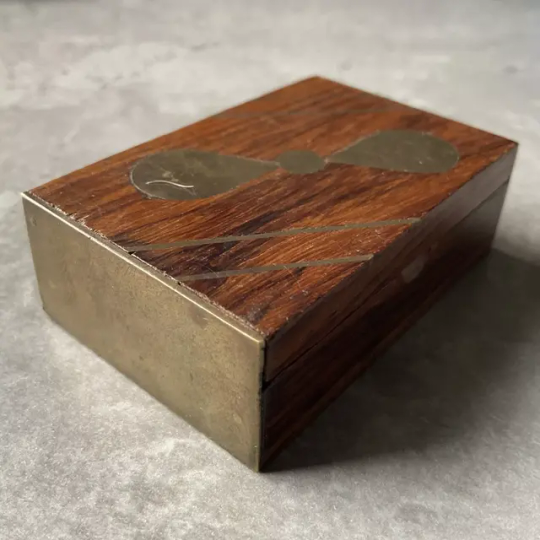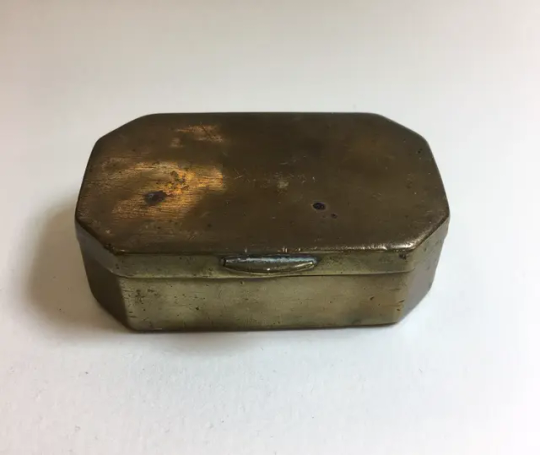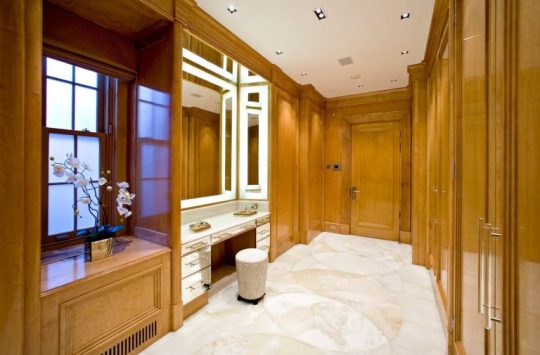#antique lacquer & inlaid furniture
Text
Contact Twig for a wonderful collection of cast iron urns and pedestals, real topiary trees, antique garden statues, turquoise canvas art, antique lacquer & inlaid furniture, antique decorative objects, garden antiques, antique garden furniture, etc. A local antiques and interiors shop in Tetbury with a broad reach to areas like London, the Cotswolds, Cheshire, Bath, bristol. Cheltenham, Gucester, Cirencester, Newbury, Oxford and America.
#antiques and interiors shop in Tetbury#contact twig#cast iron urns and pedestals#real topiary trees#antique garden statues#turquoise canvas art#antique lacquer & inlaid furniture#antique decorative objects#garden antiques#antique garden furniture#Twig Antiques & Interiors#Tetbury#UK.
0 notes
Text





Antique 1700s snuff box, black paper mache, hinged lid, lacquer leather finish ebay busterbear
Antique Solid Brass Tobacco Box Engraved Design Late 18th Early 19th Century ebay M and M Furniture UK
Exquisite Brass Inlaid Vintage Snuff Box Intricate Design & Timeless Elegance ebay Charlie Wongs Emporium
Snuff Box Antique Lacquer Lacquerware 19th Century Tobacco Box ebay Flag Meadow Antiques
2 notes
·
View notes
Photo

Eastern and Oriental Express
Oriental Express combines Southeast Asian touches with colonial embellishments. Chinese and Thai lacquer abounds, while the observation car is covered with teak paneling. The Presidential Suite, pictured here, features inlaid wood, antique brass fittings, and campaign-style furniture to accommodate the room’s small dimensions.
12 notes
·
View notes
Text
Japonisme à l’extrème
L: Title page of 1905 Yamanaka & Co Catalogue of Room Decorations and Artistic Furniture. R: No. 109. Cabinet of mulberry wood carved in designs of Angels, Phoenix and foliage. Mother of pearl inlaid work and gold lacquering.
This 1905 furniture trade catalog in the Cooper Hewitt Design Library is from the renowned Japanese art and antiques firm of Yamanaka & Co. Covered in silk brocade and bound with silk threads according to the ancient Japanese bookbinding technique of Yotsume Toji or stab-binding, it contains 36 photographic plates of elaborately carved, gilded, lacquered, and upholstered furniture made expressly for the American market.
No.54. Sofa of the Horuji Temple style. Japanese mulberry wood carved in the Phoenix design, upholstered in “Kinkara-Kawa” leather.
Founded by a prominent family of Osaka-based art dealers and connoisseurs, Yamanaka & Co.’s first branch store outside of Japan was opened in New York City in 1894 by Sadajirō Yamanaka. Specializing in high-priced art and antiquities aimed at wealthy collectors and museums, the business was among the first firms to make Asian art available in the United States, helping to popularize the market for all things Japanese in the early twentieth century.
A savvy entrepreneur, Sadajirō established himself as a tastemaker and an expert in Japanese culture. He created the persona of a specialist possessed with the authority to translate the aesthetic of the Orient to his elite clientele. To create an authentic ambience Yamanaka designed his showroom in traditional Japanese style. The firm published lavish, professionally written and photographed catalogs that provided the historical and artistic significance of the objects.
L: No.23. Library revolving chair with Lotus seat and carved lions. Magnolia hypleuca wood, lacquer and gold foil ornaments. Brocade of Paulownia Imperialus design. R: No.2. An Armchair. Lotus chair is elegantly carved and japanned in gold and colored lacquerings.
By the beginning of the twentieth century, the craze for Japonisme had found its way into middle-class homes. The American woman had become the primary consumer of household furnishings and goods. Recognizing a new potential market, in 1904 Yamanaka & Co. established a factory in Osaka to manufacture upscale room decorations and furniture for export to the US.
Targeting middle-class American women, the firm made Western style furniture, such as chairs upholstered with gilded leather or brocade made in Kyoto, but with Japanesque ornamentation.
No. 60. The “Kwagenkei” Arm-chair. Carved in mulberry wood and upholstered with “Kinkara Kawa” leather. The ornamentation was originally used for a stone gong musical instrument in the temple of Horyuji.
The furnishings were decorated with typical Japanese motifs such as dragons, phoenix birds, fruit, chrysanthemums, turtles, and fish. Through today’s eyes, these may seem overdone, heavy, and sometimes even grotesque, but such ornamentation and craftsmanship appealed to the Victorians, Edwardians, and early twentieth- century consumers.
In his introduction to this catalog Yamanaka boasted that the firm won the “Grand Prize and Gold Medal Award at the Louisiana Purchase Exposition in St. Louis, 1904”. More than just a store, Yamanaka & Co. was a cultural institution.
Adrienne Meyer was an executive in the fashion industry for twenty years, before entering the Parsons Graduate Program, graduating in 2016. She has contributed important research to special projects at The New York Historical Society and the Cooper Hewitt , Smithsonian Design Museum and Library. She recently completed a Library internship researching furniture trade catalogs.
from Cooper Hewitt, Smithsonian Design Museum https://ift.tt/2PvTe5E
via IFTTT
3 notes
·
View notes
Text
THE BEST WOOD FINISHING COMPANY IN LONDON | OSBOND & TUTT Ltd.

Wood has been used for a long time for making furnishings including tables, mattress frames, and sofas. As a herbal material, timber is prone to the consequences of ageing this means that it may end up dried out, cracked, or stained. Since biblical times, and probably before, humans have diagnosed the usefulness of coating timber surfaces with oils, balms, and unguents. Early ancient debts were determined with commands for the use of linseed or cedarwood oil to deal with timber surfaces. Other herbal oils used for sharpening timber consist of tung, and Perilla oils.
By the fourteenth century, beeswax became used to deal with inlaid timber and parquetry flooring in France. Beeswax has become a totally famous timber polish however needed to be implemented with warm irons after which hand buffed. Despite this drawback, beeswax, every so often combined with tough animal fats, remained the important shape of polish till the past due eighteenth century. In 1797, a herbal plant wax, referred to as carnauba wax, became determined at the leaves of the Brazilian cerara palm. Carnauba wax is tough, excessive melting and, while nicely compounded, imparts an excellent shine without all of the buffing required through beeswax. By the 19th century, different waxes had been determined and polishes had been evolved that applied blends of carnauba with ouricui, candelilla, esparto, sugar cane, cotton fiber, flax, palm, hemp and raffia waxes.
Today those formulations integrate herbal waxes and oils with petroleum primarily based totally substances and artificial polymers. These present day formulations can ease the movie residue and lay down new polish in an easy step so periodic stripping of vintage polish layers isn't always necessary.
The predominant motive in the back of furnishings polish is to offer the timber safety towards usual damage. Abrasions arise at the timber, for example, in case you slide a plate with a small chip on its base throughout the desk. Polish protects the desk from scratching. But whilst you polish furnishings or flooring frequently with liquid products, you assist to maintain them searching new at the same time.
Of course, you may select to strive your very own hand at sharpening your timber. However, it's tough to select and gather the proper form of polish, now no longer to say make investments exceeding quantities of effort and time to do it.
Instead, simply get in touch with us! Osbond and Tutt’s specialists are right here to help you. Our group of experts will assist you make a decision on the form of polish you want. They will deal with the entire technique for you,which includes checking if the furnishings are new or have current polish that has deteriorated over time.
WHAT WE DO?
Antique Furniture Restoration.
Traditional French polishing.
Complete furnishings repair - functional and aesthetic.
Staining and color matching.
Cleaning and reviving of existing finishes.
Stripping and polishing to match original finishes.
Veneer and inlay repair.
Removing white heat marks.
Removing water damage.
Traditional liming.
Touching in / removing scratches by hand.
Lacquering by hand.
Desktop and furnishings Re-Leathering.
Distressing.
Grain Filling.
Contemporary Spray Finishes.
Building maintenance on all timber items.
Specialist Surface Repair.
Bar top stripping and re-finishing.
Fire retardant finishes.
Specialist one off colors.
Specialist Waxing and Oiling.
External weather finishes.
Alcohol resistant finishes.
Water resistant finishes.
Gilding Repairs.
Floor stripping by hand, re-finishing in wax, oil, acrylic or solvent lacquer.
Floor Refinishing.
Wood Flooring installations using new and reclaimed timber.
Outdoor Wooden Furniture Restoration.
HOW TO CONTACT US?
For further information, please contact us on: 07850 431853 / 020 8879 1085 or e-mail us on [email protected]. You can also visit our studio at Studio One, 52 Lydden Road, Wandsworth, London, SW18 4LR.
For more information, visit our website www.osbondandtutt.co.uk.
#surfacefinishingspecialistslondon#contemporaryfinishescompanylondon#bestantiquefurniturerestorationcompanylondon#bestfurniturecompanyinlondon#bestwoodfinishingcompanyinlondon#Professionalfurniturepolishing#bestfurnitureandwoodfinishingcompanynearme#onsitespraypaintinglondon#professionalfurniturespraypaintingnearme#lacquersprayingwandsworth#howmuchdoesfrenchpolishingcostuk#Bestfurniturerepairshopinwandsworth#frenchpolishingnearme#Furniturepolishingpriceinlondon#Frenchpolishingcostpermetre#Furniturepolishingprocedure#outdoorfurniturerestorationlondon#bestspraylacquerlondon
0 notes
Text
BEST FRENCH POLISHERS IN LONDON | OSBOND and TUTT Ltd.
Wood has been used for a long time for making furnishings including tables, mattress frames, and sofas. As a herbal material, timber is prone to the consequences of ageing this means that it may end up dried out, cracked, or stained. Since biblical times, and probably before, humans have diagnosed the usefulness of coating timber surfaces with oils, balms, and unguents. Early ancient debts were determined with commands for the use of linseed or cedarwood oil to deal with timber surfaces. Other herbal oils used for sharpening timber consist of tung, and Perilla oils.
By the fourteenth century, beeswax became used to deal with inlaid timber and parquetry flooring in France. Beeswax has become a totally famous timber polish however needed to be implemented with warm irons after which hand buffed. Despite this drawback, beeswax, every so often combined with tough animal fats, remained the important shape of polish till the past due eighteenth century. In 1797, a herbal plant wax, referred to as carnauba wax, became determined at the leaves of the Brazilian cerara palm. Carnauba wax is tough, excessive melting and, while nicely compounded, imparts an excellent shine without all of the buffing required through beeswax. By the 19th century, different waxes had been determined and polishes had been evolved that applied blends of carnauba with ouricui, candelilla, esparto, sugar cane, cotton fiber, flax, palm, hemp and raffia waxes.
Today those formulations integrate herbal waxes and oils with petroleum primarily based totally substances and artificial polymers. These present day formulations can ease the movie residue and lay down new polish in an easy step so periodic stripping of vintage polish layers isn't always necessary.
The predominant motive in the back of furnishings polish is to offer the timber safety towards usual damage. Abrasions arise at the timber, for example, in case you slide a plate with a small chip on its base throughout the desk. Polish protects the desk from scratching. But whilst you polish furnishings or flooring frequently with liquid products, you assist to maintain them searching new at the same time.
Of course, you may select to strive your very own hand at sharpening your timber. However, it's tough to select and gather the proper form of polish, now no longer to say make investments exceeding quantities of effort and time to do it.
Instead, simply get in touch with us! Osbond and Tutt’s specialists are right here to help you. Our group of experts will assist you make a decision on the form of polish you want. They will deal with the entire technique for you, which includes checking if the furnishings are new or have current polish that has deteriorated over time.
We also offer services in
Antique Furniture Restoration
Complete furnishings repair - useful and aesthetic
Staining and coloration matching
Cleaning and reviving of existing finishes
Stripping and polishing to match original finishes
Veneer and inlay repair
Removing white heat marks
Removing water damage
Traditional liming
Touching in / removing scratches through hand
Lacquering by hand
Desktop and furniture Re-Leathering
Distressing
Grain Filling
Contemporary Spray Finishes
Building maintenance on all wood items
Specialist Surface Repair
Bar top stripping and re-finishing
Fire retardant finishes
Specialist one off colours
Specialist Waxing and Oiling
External weather finishes
Alcohol resistant finishes
Water resistant finishes
Gilding Repairs
Floor stripping by hand, re-finishing in wax, oil, acrylic or solvent lacquer
Floor Refinishing
Wood Flooring installations using new and reclaimed wood.
Outdoor Wooden Furniture Restoration
For any assistance and information, please contact us on: 07850 431853 / 020 8879 1085 or you may also e-mail us on [email protected]. You can also visit us at Studio One, 52 Lydden Road, Wandsworth, London, SW18 4LR.
For further information, go through our website www.osbondandtutt.co.uk.
0 notes